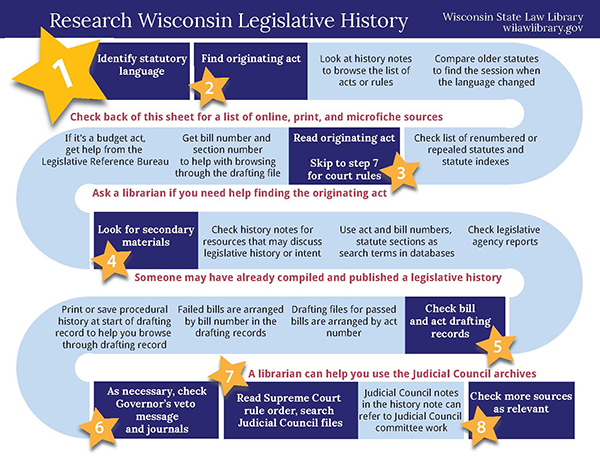Aug. 5, 2015 – Researching legislative intent can be an intimidating process. Sorting through online and print sources can feel overwhelming and the payoff potentially small. While untangling budget acts and multi-session bills can be difficult, these steps will help you through the process.
These eight steps will guide you through your research:

1. Identify statutory language
Make your life easier and target specific statutory language. Instead of asking, “What is the legislative history of Chapter 343?” a better question is, “When was the language in 343.08(1)(a) changed?” Be as specific as possible.
A place to get started is the Wisconsin Statutes & Annotations page on the Wisconsin State Legislature website.
Another place to get started is to check out the Legislative Reference Bureau’s extensive guide to Researching Legislative History in Wisconsin.
2. Find originating act
Examine the statute section’s history notes. Your source will depend on the year. For the history from 1849 through 1970, check the 1970 Wisconsin Annotations on the Wisconsin State Legislature website. For Wisconsin statutes after 1971, use Wisconsin Statutes & Annotations. West’s Wisconsin Statutes Annotated contains the history from 1849 to present.
 Carol Hassler, M.L.S., University of Illinois Urbana-Champaign, is the Web services librarian for the Wisconsin State Law Library. She teaches introductory and advanced legislative history classes at the library.
Carol Hassler, M.L.S., University of Illinois Urbana-Champaign, is the Web services librarian for the Wisconsin State Law Library. She teaches introductory and advanced legislative history classes at the library.
To narrow down the list of affecting acts, compare the statutes’ versions to find when the language changed, then use that session date as a guide to choosing the acts to read. The Wisconsin State Legislature archive holds records from 1941 to present. The print Wisconsin Statutes and Annotations holds records for 1849, 1858, 1878, 1898, and every biennium from 1911 to present.
If you reach a dead end, check the finding aids for older references. The 1970 Wisconsin Annotations covers 1913 to 1969. For research into the history of statutes, check the statutes page of the Wisconsin State Legislature website, which can provide information into repealed and renumbered statutes, sections affected by Wisconsin Acts and more – after 1970.
3. Read originating act
Act archives, going back to 1849 (with gaps), are available on the Legislature’s website. Make note of the bill number and the section number within the act in which the language changed. If it’s a large act, use the section number as you read the original bill in the drafting records.
If you discover that the changes originated in a budget act, contact the Wisconsin Legislative Reference Bureau (LRB) Library for expert assistance.
If the change originates in a Supreme Court Rule Order, move ahead to step 7.
4. Look for books and articles
Before reading through hundreds of pages of drafting records, look for other sources that may have already answered your question. Starting points include the Wisconsin State Law Library Articles & Journals page as well as its library catalogue.
Use topic terms, act and bill numbers, and statute sections as search terms in article and book databases. Legislative service agencies, such as the Legislative Council (see their publications page) and the LRB (see their publications list) publish numerous legislation and issue analyses as well.
5. Examine bill and act drafting records
Drafting files after 1999 are available online and on microfiche in select Wisconsin law libraries from 1927 to present. Drafting files are also available at the source through the LRB.
Drafting files for passed bills are arranged by act number; files for failed bills are arranged by bill number. Examining failed bills can be useful when legislation is based off of a failed bill from an earlier session. Many drafting files include a procedural history at the beginning of the file. Print or save the procedural history to refer to as you read the drafting file.
6. Check governor’s veto message and journals
Senate and assembly journals provide a simple record of actions taken (such as votes) and are largely used by researchers focusing on history, rather than legislative intent. Procedural histories, if not included at the beginning of a drafting file, can also be found in legislative journals and the bulletin of proceedings for each house. They can be reached via the documents page of the Wisconsin State Legislature website. Individual procedural histories can be found online through the bill number.
A governor’s veto message can be useful as an overview of why certain language was vetoed or to give a broad idea of the intent behind legislation. The messages can be found on the Wisconsin Legislature’s Session Archive, covering 1995 to present.
7. Supreme Court Rule Order, Judicial Council files
When a statute section is affected by a Supreme Court Rule Order, look at judicial resources.
Orders are published in Wisconsin Reports, so citations in a statute’s history note will include a Wis. or Wis. 2d citation. Rule orders are online back to 1995; older orders are available at the Wisconsin State Law Library, or by contacting the Clerk of the Supreme Court and the Court of Appeals. Rule orders are not available in Westlaw or Lexis.
Rule order research is often augmented by Judicial Council materials. The Wisconsin Judicial council generates proposals from study committees or contributes statements about rule changes. Archived background materials and minutes for the Judicial Council can be researched at the Wisconsin State Law Library. It is common to find Judicial Council notes in a statute that has been affected by a Supreme Court Rule.
8. Check other sources as relevant
If you still need to fill in some gaps after reading the drafting file or judicial background materials, other resources can help you out:
For more detailed help check out the Legislative Reference Bureau’s extensive guide to Researching Legislative History in Wisconsin.
If you get stuck, ask a state law librarian or your local law librarian for help.
